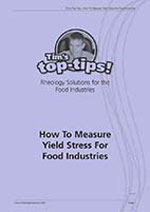Explanation and Evaluation Series
Often the industry must overcome problems related to (and often dominated by) the flow properties of their product, through the relationship between these properties and production related issues are not always immediately apparent. It is the purpose of this series of articles, to help illuminate the issues faced by the industry, how they relate to the flow properties of the problem materials and how they can be successfully measured and controlled with a view to better processing.
 Food Industries – Tim’s Top Tips Explanation & Evaluation of Cohesiveness, Cohesion Strength & Cohesive Quality
Food Industries – Tim’s Top Tips Explanation & Evaluation of Cohesiveness, Cohesion Strength & Cohesive QualityCohesiveness, cohesion strength and cohesive quality are interrelated properties, traditionally measured as a textural component of solid or semi-solid foods. Read More »
Mouthfeel is the textural part of the experience of the consumer when chewing and swallowing food. Read More »
Processability is related to the amount of energy required to perform the relevant production steps for a food product. Read More »
Shelf life is the maximum time interval in which a material may be kept in a usable condition during storage. Read More »
Compounding is the process of combining polymers and other materials by dry blending or melt state blending. Read More »
Die swell occurs when an extrudate has larger diameter than the die. Read More »
Processability is related to the amount of energy required to perform the relevant production steps for a product. Read More »
Sharkskin is a surface mattness seen on an extrudate during processing. Read More »
A flow curve is a data plot showing the results of an experiment, relating the shear rate to the shear stress. Read More »
Misting is the poor finish quality due to the splitting of the film between the roller and the substrate, resulting in a mist of particles settling onto the surface of the coating, resulting in an ‘orange-peel’ effect. Read More »
Blending and mixing entails the combination of materials to give the desired physical or chemical properties. Read More »
Shelf life is the maximum time interval in which a material may be kept in a usable condition during storage. Read More »
How to Measure Series
The notes focus on commonly encountered measurement issues and suggest solutions for solving these challenges. Each application note includes: working definitions, background and discussion comparing current testing procedures and methods and summaries the measuring techniques in a comparison table by method/instrument used.
A flow curve is a data plot showing the results of an experiment, relating the shear rate to the shear stress. Read More »
Thixotropy is a form of time dependent behaviour describing a material whose viscosity decreases over time while it is subjected to shearing forces. Read More »
Yield stress is the minimum force required to initiate flow. Read More »
 Chemical and General Manufacturing Industries – Tim’s Top Tips How to Measure Flow and Viscosity Curves
Chemical and General Manufacturing Industries – Tim’s Top Tips How to Measure Flow and Viscosity CurvesA flow curve is a data plot showing the results of an experiment, relating the shear rate to the shear stress. Read More »
Thixotropy is a form of time dependent behaviour describing a material whose viscosity decreases over time while it is subjected to shearing forces. Read More »
Yield stress is the minimum force required to initiate flow. Read More »
A flow curve is a data plot showing the results of an experiment, relating the shear rate to the shear stress. Read More »
Thixotropy is a form of time dependent behaviour describing a material whose viscosity decreases over time while it is subjected to shearing forces. Read More »
Yield stress is the minimum force required to initiate flow. Read More »
A flow curve is a data plot showing the results of an experiment, relating the shear rate to the shear stress. Read More »
Thixotropy is a form of time dependent behaviour describing a material whose viscosity decreases over time while it is subjected to shearing forces. Read More »
Yield stress is the minimum force required to initiate flow. Read More »
 Pharmaceutical, Cosmetic & Allied Industries – Tim’s Top Tips How to Measure Flow and Viscosity Curves
Pharmaceutical, Cosmetic & Allied Industries – Tim’s Top Tips How to Measure Flow and Viscosity CurvesA flow curve is a data plot showing the results of an experiment, relating the shear rate to the shear stress. Read More »
Thixotropy is a form of time dependent behaviour describing a material whose viscosity decreases over time while it is subjected to shearing forces. Read More »
Yield stress is the minimum force required to initiate flow. Read More »
A flow curve is a data plot showing the results of an experiment, relating the shear rate to the shear stress. Read More »
Thixotropy is a form of time dependent behaviour describing a material whose viscosity decreases over time while it is subjected to shearing forces. Read More »
Yield stress is the minimum force required to initiate flow. Read More »
A flow curve is a data plot showing the results of an experiment, relating the shear rate to the shear stress. Read More »
Thixotropy is a form of time dependent behaviour describing a material whose viscosity decreases over time while it is subjected to shearing forces. Read More »
Yield stress is the minimum force required to initiate flow. Read More »






























